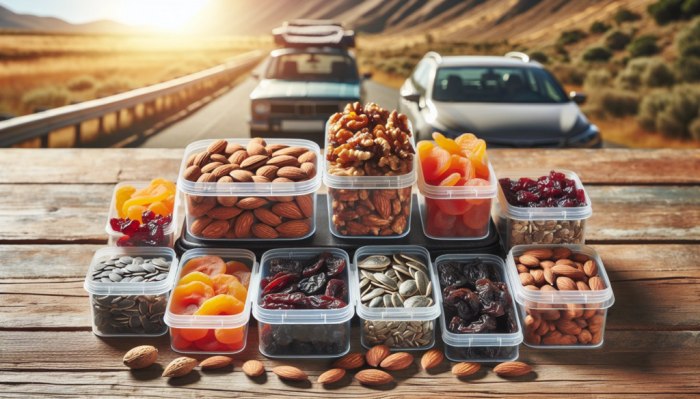
Embarking on a culinary adventure while traveling should be a delightful experience, not a health hazard. This guide provides practical strategies for savoring authentic local cuisine without compromising your well-being. We’ll cover everything from planning your meals and identifying safe food vendors to navigating cultural nuances and handling unexpected situations like food poisoning. Prepare to indulge responsibly and create unforgettable memories fueled by delicious and healthy food.
From meticulously crafting a balanced meal plan incorporating regional specialties to mastering the art of ordering food in unfamiliar languages, we’ll equip you with the knowledge and confidence to navigate diverse culinary landscapes. We’ll also explore the importance of hydration, safe food handling, and the role of travel insurance in protecting your health. This comprehensive guide aims to make your food-focused travels both delicious and safe.
Planning Your Healthy Food Trip

Embarking on a culinary adventure should be a delightful experience, but it’s crucial to plan ahead to ensure both enjoyment and well-being. Careful consideration of your dietary needs and the local food scene will help you savor authentic dishes while maintaining a healthy balance. This involves researching local cuisine, planning meals, and prioritizing safe food choices.
Must-Try Local Dishes in Chiang Mai, Thailand
Choosing a specific destination allows for a more focused exploration of healthy eating options. Let’s consider Chiang Mai, Thailand, known for its vibrant and diverse culinary landscape. The following table highlights five must-try dishes, their ingredients, potential health benefits, and any potential risks:
| Dish Name | Ingredients | Health Benefits | Potential Risks |
|---|---|---|---|
| Khao Soi | Coconut milk, curry paste, noodles, chicken or tofu, lime, cilantro | Provides carbohydrates for energy, protein for muscle building, and healthy fats from coconut milk. The curry paste contains turmeric, known for its anti-inflammatory properties. | High in fat and sodium, potentially leading to digestive upset if consumed in large quantities. May not be suitable for those with dairy allergies (due to coconut milk). |
| Gaeng Hung Lay (Burmese-style curry) | Pork belly, tomatoes, potatoes, ginger, garlic, chilies | Rich in vitamins and minerals from vegetables. Provides protein from pork (or can be substituted with tofu for vegetarians). | High in fat and sodium if pork belly is used. The chilies can cause digestive discomfort for some individuals. |
| Sai Oua (Northern Thai sausage) | Ground pork, lemongrass, galangal, chilies, kaffir lime leaves | Provides protein from pork. Lemongrass and galangal offer potential antioxidant benefits. | High in fat and sodium. May contain high levels of sodium nitrite (a preservative) which is a potential health concern in large amounts. |
| Nam Prik Ong (Northern Thai chili dip) | Tomatoes, chilies, garlic, shallots, pork, coconut milk | Provides vitamins and minerals from tomatoes. The chilies can boost metabolism. | Very spicy; may cause stomach upset for those sensitive to spice. High in fat and sodium. |
| Mango Sticky Rice | Glutinous rice, coconut milk, mango | Provides carbohydrates for energy. Mango is rich in vitamins A and C. | High in sugar and carbohydrates; should be consumed in moderation. |
Sample 7-Day Meal Plan in Chiang Mai
A well-structured meal plan ensures a balanced intake of nutrients while allowing you to explore the local cuisine. This sample plan incorporates a variety of dishes while considering potential health impacts.
- Day 1: Breakfast: Fresh fruit and yogurt; Lunch: Khao Soi (smaller portion); Dinner: Gaeng Hung Lay with brown rice.
- Day 2: Breakfast: Oatmeal with berries; Lunch: Sai Oua (small amount) with a side salad; Dinner: Stir-fried vegetables with tofu.
- Day 3: Breakfast: Tropical fruit smoothie; Lunch: Leftover Gaeng Hung Lay; Dinner: Mango sticky rice (small portion).
- Day 4: Breakfast: Scrambled eggs with whole-wheat toast; Lunch: Street food (choose grilled options like chicken or fish); Dinner: Vegetable curry with brown rice.
- Day 5: Breakfast: Yogurt with granola; Lunch: Khao Soi (smaller portion); Dinner: Nam Prik Ong with vegetables and sticky rice (small amount).
- Day 6: Breakfast: Fruit salad; Lunch: Leftover vegetable curry; Dinner: Grilled fish with a side salad.
- Day 7: Breakfast: Pancakes with fruit; Lunch: Street food (choose healthier options); Dinner: Simple noodle soup.
Identifying Reputable Food Vendors
Locating trustworthy food vendors is paramount for maintaining hygiene and avoiding foodborne illnesses. Several strategies can help you make informed choices. Look for busy establishments – high turnover often indicates fresh food and good quality. Observe the cleanliness of the food preparation area and the vendor’s personal hygiene. Choose vendors with readily visible food handling practices, and don’t hesitate to ask questions about ingredients and preparation methods.
Opt for cooked food over raw, and avoid food that has been sitting out at room temperature for extended periods. Prioritize vendors with good reviews online or recommendations from locals.
Navigating Local Markets and Restaurants

Exploring local markets and restaurants is a crucial part of experiencing a new culture, but it also presents unique challenges, particularly regarding food safety and communication. Understanding the nuances of different food safety standards and developing effective communication strategies are key to enjoying delicious and healthy meals abroad. This section will explore these aspects, providing practical tips for a safe and rewarding culinary adventure.Food safety standards vary significantly across countries, impacting the risk of foodborne illnesses.
Let’s compare and contrast the practices in two locations: the United States and Thailand.
Food Safety Standards in the United States and Thailand
The United States has a robust food safety infrastructure, with stringent regulations governing food production, processing, and handling. The Food and Drug Administration (FDA) and the United States Department of Agriculture (USDA) play significant roles in setting and enforcing these standards. For instance, restaurants are regularly inspected, and food handlers are required to maintain high hygiene standards. Proper temperature control is strictly enforced, minimizing the risk of bacterial growth.
However, even in the US, foodborne illnesses still occur, often due to human error or lapses in hygiene practices in smaller establishments.In contrast, Thailand’s food safety regulations, while improving, are less stringent than those in the US. Street food, a significant part of Thai culinary culture, is often prepared and sold in less regulated environments. While many street food vendors maintain high hygiene standards, the lack of consistent oversight increases the risk of contamination.
For example, improper handwashing or inadequate cooking temperatures could lead to foodborne illnesses. However, it’s important to note that many Thai street food vendors prioritize hygiene and use fresh, high-quality ingredients, resulting in safe and delicious meals. The key difference lies in the level of consistent regulatory enforcement and inspection.
Ordering Food Safely and Effectively in a Foreign Language
Communicating your dietary needs and preferences when you don’t speak the local language can be daunting. However, with a few simple strategies, you can navigate restaurant menus and ensure a safe and enjoyable dining experience. Preparation and clear communication are key.Preparing for your meal involves learning a few essential phrases. For example, knowing how to ask for the menu (“Menu, please” in various languages) is crucial.
Learning phrases like “no spice” (which varies greatly by language and culture), “no meat” (vegetarian), or “no dairy” (vegan) can be invaluable. Additionally, visual aids such as pictures on your phone can be extremely helpful.Using a translation app can be incredibly beneficial. Many apps allow you to translate phrases in real-time, and some even offer voice-to-text capabilities for easier communication.
Pointing at menu items and using gestures can also be helpful, combined with your translated phrases. For example, instead of saying “I’d like the chicken dish without spice,” you might point at the chicken dish and then use your translation app to say “no spice.”
Useful Phrases: “Menu, please,” “No spice,” “No meat,” “No dairy,” “This please,” “Thank you,” “The bill, please.” (Note: These need to be translated into the local language.)
Managing Food Poisoning While Traveling
Encountering food poisoning while traveling is unfortunately a possibility. Being prepared with a plan of action can significantly reduce the severity and duration of the illness.A flowchart outlining the steps to take when encountering food poisoning:[Imagine a flowchart here. The flowchart would begin with a “Yes/No” decision box: “Are you experiencing symptoms of food poisoning (nausea, vomiting, diarrhea, etc.)?” If yes, the next box would be “Seek medical attention if symptoms are severe (high fever, dehydration, bloody stool).” If no, the next box would be “Stay hydrated (drink plenty of clear fluids like water or electrolyte drinks).” The next box would be “Rest and avoid solid foods for a period of time.” The final box would be “Gradually reintroduce bland foods as symptoms improve.” If the initial answer was no, the flowchart would end.
If medical attention is sought, a separate branch would be added showing the steps of seeking medical care and follow-up.]
Staying Healthy While Indulging
Enjoying local cuisine is a significant part of any travel experience, but maintaining your health shouldn’t be sacrificed for culinary adventures. Staying hydrated, making smart food choices, and practicing mindful eating will ensure you return home feeling refreshed and energized, not depleted. This section will offer practical strategies to help you achieve this balance.Staying properly hydrated is crucial, especially in warmer climates.
Dehydration can lead to fatigue, headaches, and even more serious health issues. It’s easy to overlook fluid intake when exploring new places, but proactive hydration is key to enjoying your trip fully.
Hydration Strategies for Hot Climates
Maintaining adequate hydration in hot climates requires a conscious effort. Simply carrying a reusable water bottle and refilling it throughout the day is a good start. However, consider these additional strategies for enhanced hydration:
- Consume hydrating fruits and vegetables: Watermelon, cucumbers, and oranges are naturally high in water content and offer refreshing hydration alongside essential vitamins and minerals.
- Choose electrolyte-rich beverages: Electrolyte drinks, such as coconut water or diluted sports drinks, can replenish electrolytes lost through sweat, particularly after physical activity. Be mindful of added sugars in commercial sports drinks.
- Carry a portable water filter or purification tablets: These provide a safety net, allowing you to safely drink water from various sources, especially when bottled water isn’t readily available or is expensive.
- Pace your alcohol consumption: Alcoholic beverages can contribute to dehydration, so consume them in moderation, particularly in hot weather. Alternate alcoholic drinks with water to stay adequately hydrated.
- Avoid sugary drinks: Sugary sodas and juices offer minimal nutritional value and can contribute to dehydration. Opt for water or naturally hydrating beverages.
Water Purification Methods: Tablets vs. Filters
Water purification tablets and filters offer different approaches to safe drinking water. Tablets are lightweight and convenient for backpacking or situations where access to clean water is limited. However, they may not remove all contaminants and require a waiting period for the purification process to complete. Filters, while bulkier, often provide more thorough purification and remove a wider range of impurities.The choice between tablets and filters depends on your specific travel style and needs.
Backpackers might prefer the lightweight convenience of tablets, while travelers staying in hotels or guesthouses might find a portable filter more suitable. It’s crucial to follow the manufacturer’s instructions carefully for both tablets and filters to ensure effective purification.
Healthy Travel Snacks
Packing healthy snacks can prevent impulsive unhealthy choices and maintain energy levels throughout your travels. Prioritize snacks that are lightweight, non-perishable, and nutritious.
- Trail mix: A combination of nuts, seeds, and dried fruits provides healthy fats, protein, and fiber.
- Energy bars: Choose bars with minimal added sugar and high protein content for sustained energy.
- Dried fruit: Apricots, cranberries, and mangoes offer a concentrated source of vitamins and minerals, but watch for added sugar.
- Whole-grain crackers: Pair these with nut butter or hummus for a balanced snack.
- Nuts and seeds: Almonds, walnuts, sunflower seeds, and pumpkin seeds provide healthy fats and protein.
Cultural Sensitivity and Food Choices
Exploring the world’s culinary landscape is a rewarding experience, but it’s crucial to approach it with respect for local customs and traditions. Understanding the cultural significance of food and navigating dietary needs sensitively enhances the travel experience and fosters meaningful connections with the communities you visit. This section explores the importance of cultural sensitivity in food choices while traveling, offering practical guidance on navigating diverse culinary landscapes respectfully.
Let’s delve into the rich cultural tapestry woven into the fabric of food traditions. Consider the Japanese tea ceremony, chado. More than just a beverage, it’s a deeply ritualistic practice steeped in centuries of history. Its origins trace back to the Zen Buddhist monasteries of the 12th century, evolving over time into a refined art form.
The preparation, presentation, and consumption of matcha, a finely powdered green tea, are all imbued with symbolic meaning, representing harmony, respect, and mindfulness. The specific type of bowl, the whisk used, the precise movements of the host – all contribute to the ceremony’s aesthetic and spiritual significance. Participating in a tea ceremony provides a window into Japanese culture, revealing its emphasis on precision, aesthetics, and the interconnectedness of nature and humanity.
The quiet contemplation and mindful appreciation of the tea itself are a powerful cultural experience.
Respecting Dietary Restrictions and Allergies Abroad
Communicating dietary restrictions or allergies while traveling internationally requires proactive planning and clear communication. Before your trip, learn basic phrases related to your dietary needs in the local language. Download translation apps and utilize visual aids, such as pictures of the foods you can and cannot eat. When dining out, it’s always best to inform the waitstaff about your allergies or restrictions clearly and directly.
Don’t hesitate to ask questions about ingredients and preparation methods to ensure your safety. Carrying a concise, translated card outlining your allergies can be incredibly helpful, especially in areas where English proficiency might be limited. Be aware that food labeling regulations vary across countries; relying solely on labels may not always be sufficient. Consider carrying suitable snacks and non-perishable food items, especially for situations where finding suitable alternatives might be challenging.
Navigating Food Etiquette in Different Cultures
Understanding basic food etiquette demonstrates respect for local customs and enhances your travel experience. Practices vary significantly across cultures. In some cultures, using chopsticks correctly is essential, while in others, using your hands is the norm. In many Asian countries, leaving food on your plate can be seen as disrespectful, signifying that you weren’t satisfied with the portion or the meal itself.
In some Middle Eastern cultures, sharing food is a central aspect of social interaction, emphasizing community and hospitality. In some parts of Europe, leaving a small amount of food on your plate might be interpreted as a sign that you were satisfied. Researching common etiquette practices for the regions you’ll be visiting is essential for a smooth and culturally sensitive experience.
Observing the actions of locals and asking politely if unsure about a particular custom is always a good approach.
Travel Hacks for Foodies
Discovering the best culinary experiences in a new city often involves venturing beyond the well-trodden tourist paths. This section unveils practical strategies and tools to help you uncover hidden gastronomic gems and savor local flavors without overspending. We’ll explore effective methods for locating authentic eateries and employing technology to enhance your culinary adventures.Finding Hidden Culinary GemsUncovering hidden culinary gems requires a blend of proactive exploration and local insight.
One effective approach is to wander beyond the main tourist areas. Often, the most authentic and delicious food is found in residential neighborhoods, away from the crowds. Look for bustling street food stalls or small, family-run restaurants that may not be featured in guidebooks. Another excellent strategy is to engage with locals. Ask your hotel staff, taxi drivers, or even shopkeepers for their recommendations on favorite local eateries.
Their insider knowledge can lead you to places you wouldn’t otherwise find. Finally, consider exploring local markets. These vibrant hubs are not only great places to purchase fresh produce but also often house small food vendors offering delicious and affordable meals. The energy and aromas alone are worth the visit.Utilizing Travel Apps for Food DiscoveryNumerous travel apps can significantly enhance your culinary exploration.
Apps like Yelp, TripAdvisor, and Google Maps provide user reviews, photos, and location information for restaurants, cafes, and street food stalls. These platforms allow you to filter searches based on cuisine type, price range, and user ratings, helping you quickly identify potential dining spots that align with your preferences. Many apps also offer features such as online reservations and menus, making planning your meals easier and more efficient.
Additionally, some apps specialize in local food experiences, offering curated lists of hidden gems or opportunities to participate in food tours and cooking classes. These specialized apps can be particularly useful for discovering unique and authentic culinary experiences.Budget-Friendly Tips for Enjoying Local FoodEnjoying authentic local cuisine doesn’t have to break the bank. Here are five budget-friendly tips:
- Embrace Street Food: Street food stalls often offer the most authentic and affordable meals. The vibrant atmosphere and diverse options provide a truly immersive culinary experience.
- Eat Like a Local: Opt for local eateries frequented by residents rather than tourist-centric restaurants. Prices are generally lower, and the food is often more authentic.
- Explore Local Markets: Markets offer fresh, affordable produce and ingredients. Pick up some snacks and prepare your own meals to save money.
- Take Advantage of Lunch Specials: Many restaurants offer discounted lunch menus, providing a cost-effective way to enjoy a delicious meal.
- Look for Happy Hour Deals: Some establishments offer discounted drinks and appetizers during happy hour, providing a budget-friendly way to enjoy a pre-dinner snack or drink.
Travel Insurance and Food-Related Issues
Travel insurance plays a crucial role in mitigating the financial burden associated with unexpected health issues while traveling, particularly those related to food. Food poisoning and allergic reactions can lead to significant medical expenses, including doctor visits, hospital stays, medication, and even emergency evacuation. Comprehensive travel insurance can provide vital coverage for these unforeseen circumstances, offering peace of mind and protecting your finances.A robust travel insurance policy should cover medical expenses resulting from foodborne illnesses or allergic reactions incurred during your trip.
This typically includes costs associated with consultations, treatments, hospitalization, and medication prescribed by medical professionals. Some policies even extend coverage to emergency medical evacuation, should your condition require transport back to your home country for specialized care. It is vital to carefully review your policy’s terms and conditions to understand the extent of coverage offered for food-related medical emergencies.
The specific coverage amounts and limitations will vary depending on the insurer and the chosen plan.
Filing a Claim for Food-Related Medical Emergencies
The process of filing a claim for food-related medical emergencies generally involves several steps. First, it is crucial to seek immediate medical attention from a qualified healthcare professional. Obtain all necessary documentation, including medical bills, doctor’s reports, and any other relevant paperwork related to the incident. These documents will serve as evidence to support your claim. Next, contact your travel insurance provider as soon as possible to report the incident and initiate the claims process.
They will guide you through the required procedures and provide you with the necessary claim forms. Be sure to follow their instructions carefully and submit all required documentation promptly to expedite the claims process. Depending on your policy and the complexity of your claim, the processing time may vary. Maintain open communication with your insurer throughout the process, addressing any queries or requests for additional information in a timely manner.
Prompt and accurate communication is key to a smooth and successful claim resolution. Remember to retain copies of all correspondence and documents related to your claim.
Capturing Culinary Adventures
Food photography is an essential part of documenting your culinary travels. Appealing photos not only serve as lasting memories but also allow you to share your experiences with others, inspiring their own food adventures. Mastering a few key techniques can significantly elevate your food photography skills, transforming snapshots into stunning visuals.Taking captivating food photos requires attention to detail and understanding of basic photographic principles.
By focusing on composition and lighting, you can create images that accurately reflect the deliciousness and cultural significance of the dishes you encounter. Remember, the goal is to evoke a sense of place and experience through your photographs.
Food Photography Composition Techniques
Effective composition is key to creating visually appealing food photos. Consider these techniques to improve your shots:
Rule of Thirds: Instead of placing your subject directly in the center, imagine your frame divided into nine equal parts by two equally-spaced horizontal lines and two equally-spaced vertical lines. Position key elements along these lines or at their intersections for a more balanced and dynamic composition. For example, a bowl of vibrant pasta could be positioned along the bottom horizontal line, with a garnish placed at one of the intersections.
Leading Lines: Use natural lines within the scene – like a road, a river, or even the lines of a table setting – to guide the viewer’s eye towards your food. A photo of a street food stall, with the lines of the street leading to the stall and the food, creates a sense of depth and visual interest.
Negative Space: Don’t overcrowd your frame. Leave some empty space around your subject to allow it to breathe and stand out. A simple plate of freshly baked bread against a plain, light-colored background can be more impactful than a cluttered table setting.
Optimizing Lighting for Food Photography
Lighting is crucial in food photography. Natural light is generally preferred, as it provides soft, even illumination.
Natural Light: Shoot near a window, preferably during the golden hour (sunrise or sunset) for warm, flattering light. Avoid harsh midday sun, which can create harsh shadows and wash out colors. A plate of colorful tapas, photographed near a window during sunset, would showcase the rich hues of the ingredients beautifully.
Artificial Light: If natural light is unavailable, use a diffuser to soften the light from artificial sources. Avoid using the built-in flash on your camera, as it can create harsh shadows and an unappealing look. A tripod can also be useful to prevent blurry images when using lower light conditions.
Reflectors: To fill in shadows, use a reflector (a white or silver surface) to bounce light back onto your subject. A simple piece of white cardboard can work well. For instance, reflecting light onto the side of a bowl of soup can reduce shadows and highlight its texture.
Creating a Memorable Social Media Post
Sharing your culinary adventures on social media allows you to connect with others and inspire their own travel experiences.
Image Selection: Choose your best photo – one that showcases the food in a visually appealing way, highlighting its texture, color, and overall appeal. Imagine a picture of a steaming bowl of pho, with the broth glistening and herbs artfully arranged.
Caption Writing: Write a detailed caption that transports your followers to your location. Include details about the dish, the restaurant (if applicable), and your overall experience. For example: “Indulged in the most incredible bowl of Pho in Hanoi, Vietnam! The rich broth, perfectly cooked noodles, and fresh herbs were a symphony of flavors. Highly recommend trying this authentic Vietnamese street food gem at [Restaurant Name].”
Hashtags: Use relevant hashtags to increase the visibility of your post. Consider hashtags such as #travelfood, #foodie, #vietnamfood, #hanoi, #pho, and others relevant to your location and the specific dish.
Geotag: Geotag your post to show your location and allow others to easily find your recommended food spots. This adds another layer of context and allows for engagement with people in the area or those planning a trip to the same destination.
Travel Visa and Urban Escapes
Planning a culinary adventure requires careful consideration of both the gastronomic delights and the logistical aspects of travel. Securing the necessary visa and choosing the right type of destination are crucial steps in ensuring a smooth and enjoyable trip. This section will address visa requirements for a specific country known for its cuisine and explore the advantages of urban escapes for food-focused travel.Urban escapes offer significant advantages for culinary-focused trips, particularly for first-time international travelers.
The concentration of diverse restaurants, markets, and culinary experiences within a city simplifies the exploration process, maximizing the opportunity to sample a wide range of local flavors and dishes within a manageable timeframe. Furthermore, urban environments typically offer more accessible and reliable transportation options, making it easier to navigate between different culinary destinations.
Visa Requirements for Visiting Italy
Italy, renowned for its rich culinary heritage, ranging from Roman pasta dishes to Neapolitan pizzas and Tuscan regional specialties, requires visitors to obtain a Schengen Visa if they are not citizens of a country exempt from visa requirements. The specific requirements for a Schengen Visa vary depending on the applicant’s nationality and purpose of travel. Generally, applicants need to provide proof of sufficient funds, travel itinerary, accommodation details, and health insurance.
The application process typically involves submitting an application form, passport photos, and supporting documents to the Italian embassy or consulate in their home country. Processing times can vary, so it’s crucial to apply well in advance of the intended travel dates. Failure to obtain the necessary visa before travel can result in being denied entry into the country.
Detailed information on visa requirements can be found on the website of the Italian embassy or consulate in your country of residence, or through the official website of the Italian Ministry of Foreign Affairs.
Benefits of Urban Escapes for Culinary Travel
Choosing an urban destination for a culinary trip offers several key benefits. Firstly, cities tend to be hubs of culinary diversity, offering a wide array of restaurants, street food vendors, and markets representing various cuisines and price points. This concentration of culinary experiences allows travelers to sample a broad range of dishes and flavors in a short period.
Secondly, urban areas usually have better infrastructure for food tourism, including easily accessible public transport, detailed maps, and readily available information about restaurants and food tours. This makes it simpler to navigate the culinary landscape and plan your itinerary efficiently. Thirdly, the vibrant atmosphere of a city adds to the overall enjoyment of the culinary experience. The energy and diversity of urban life create a stimulating backdrop for exploring new tastes and flavors.
For example, a culinary trip to a city like Bangkok or Mexico City offers an immersive experience, going beyond simply eating; it’s about engaging with the local culture and the vibrant culinary scenes that thrive within the city’s heart.
Vacation Packages and Programs
Choosing the right vacation package can significantly enhance your culinary adventure. Pre-arranged tours often streamline the process, offering curated experiences that blend cultural immersion with gastronomic exploration. However, the level of personalization and control varies greatly depending on the package selected. Understanding the differences between various options allows for a more informed decision, ensuring a trip perfectly tailored to your preferences.Exploring two distinct vacation packages highlights the spectrum of possibilities available to food-focused travelers.
One approach emphasizes structured itineraries with pre-booked meals and activities, while another prioritizes flexibility and independent exploration. This comparison will illuminate the advantages and disadvantages of each approach, helping you determine which style best aligns with your travel style and budget.
Comparison of Two Food-Focused Vacation Packages
Let’s compare a “Taste of Tuscany” package offered by a reputable travel agency against a customizable “Culinary Exploration of Southeast Asia” program. The “Taste of Tuscany” package includes pre-arranged accommodations in charming Tuscan villages, guided tours of vineyards and olive groves, cooking classes focusing on regional specialties, and pre-booked dinners at renowned restaurants. This package provides a structured and relatively stress-free experience, guaranteeing a taste of authentic Tuscan cuisine and culture.
However, spontaneity is limited, and dietary restrictions might be challenging to accommodate fully within the pre-set itinerary. The cost is typically higher due to the inclusive nature of the package.In contrast, the “Culinary Exploration of Southeast Asia” program offers a more flexible approach. It provides a framework of suggested activities, including market visits, cooking classes, and restaurant recommendations, but allows for significant customization.
Travelers choose their own accommodations, transportation, and dining experiences, offering greater control over their budget and itinerary. This approach demands more independent planning and research, but it allows for greater personalization and the opportunity to discover hidden culinary gems. The potential for cost savings is significant, but the increased responsibility requires a proactive and organized approach to travel planning.
Creating a Personalized Culinary Vacation Program
Crafting a personalized culinary vacation requires meticulous planning and research. Begin by identifying your target destination and the specific culinary aspects that interest you. Are you fascinated by street food, fine dining, or regional specialties? Do you prefer hands-on experiences like cooking classes, or do you prefer guided food tours? Once your culinary focus is established, research the destination’s food scene, identifying key restaurants, markets, and culinary experiences that align with your preferences.Next, consider the length of your trip and allocate sufficient time for each activity.
Factor in travel time between locations and ensure a balanced itinerary that prevents over-scheduling and allows for spontaneity. Utilize online resources such as travel blogs, food websites, and local tourism boards to gather information. Engage with local food communities online for insider tips and recommendations. Finally, book accommodations and transportation in advance, particularly if traveling during peak season.
Remember to build in buffer time for unexpected delays or changes in plans. A detailed itinerary, including contact information for all booked services, will ensure a smooth and enjoyable culinary adventure.
Venture Capital and the Food Industry (Tangential, for broader context)
Venture capital (VC) plays a significant role in shaping the food industry, particularly in fostering innovation and growth within specific geographical regions. Its influence extends beyond simple financial investment, impacting the development of new technologies, business models, and ultimately, the food we consume. This examination will focus on the impact of VC funding in the burgeoning food tech scene of Southeast Asia.The Southeast Asian food industry is a dynamic and rapidly expanding market, characterized by a diverse range of culinary traditions and a large, young population with increasing disposable incomes.
This presents a fertile ground for food-related startups, many of which require significant capital investment for scaling operations, research and development, and marketing. Venture capital firms recognize this potential and are actively investing in companies across various segments of the food industry.
Venture Capital Investments in Southeast Asian Food Tech
Southeast Asia has witnessed a surge in VC funding for food tech companies in recent years. This investment is targeted at various sub-sectors, including food delivery platforms, agritech solutions, plant-based meat alternatives, and food processing technologies. For example, Grab, a ride-hailing app that expanded into food delivery, has secured substantial VC funding, enabling its rapid growth across the region.
Similarly, companies focusing on sustainable agriculture and reducing food waste are attracting significant interest from investors seeking both financial returns and positive social impact. The specific allocation of funds varies based on market trends and investor priorities, but the overall trend indicates a strong belief in the long-term potential of the Southeast Asian food tech sector.
Impact of VC Funding on Innovation
Access to VC funding allows food tech companies to accelerate innovation by investing in research and development. This can lead to the development of novel food products, more efficient farming practices, and improved supply chain management. For instance, companies using AI and machine learning to optimize food production or predict consumer demand are leveraging VC funding to scale their operations and reach a wider market.
The competitive landscape fostered by VC investment encourages continuous improvement and the adoption of cutting-edge technologies, ultimately benefiting consumers through greater choice, affordability, and sustainability.
Challenges and Opportunities in VC-Funded Food Tech
While the influx of VC funding presents significant opportunities, it also presents challenges. Competition for funding can be fierce, requiring startups to demonstrate strong potential for growth and return on investment. Furthermore, navigating regulatory hurdles and ensuring sustainable practices remain crucial aspects of successful VC-backed food tech ventures. Despite these challenges, the continued growth of the Southeast Asian economy and the increasing demand for innovative food solutions suggest that the role of venture capital in the region’s food industry will only continue to expand.
Ultimately, the joy of travel lies in experiencing new cultures, and food is a central part of that experience. By following these tips, you can confidently explore diverse culinary traditions, savor authentic flavors, and return home with enriching memories and a healthy body. Remember that mindful planning, cultural sensitivity, and a proactive approach to food safety are key ingredients to a successful and delicious trip.
Bon appétit!
Q&A
What if I have severe allergies?
Carry a detailed list of your allergies (in the local language if possible) and know how to explain them clearly. Inform your hosts or servers immediately. Always carry your epinephrine auto-injector if necessary.
How can I avoid getting sick from street food?
Choose vendors with high turnover (food selling quickly suggests freshness). Look for busy stalls with lots of customers. Avoid raw or undercooked food and ensure food is steaming hot.
What’s the best way to purify water while traveling?
Water purification tablets or a reliable filter are excellent options. Boiling water for at least one minute is also effective. Always check the local water safety advisories.
What should I do if I get food poisoning?
Drink plenty of fluids to rehydrate, and rest. If symptoms are severe (high fever, persistent vomiting/diarrhea), seek immediate medical attention.






